Britain's clean fuel shame: how the UK has fallen out of the hydrogen car race
Hydrogen fuel cells that emit nothing more toxic than water were invented in 1842 — by a Briton. Now California and Japan are producing cars and infrastructure for a carbon-free future, leaving the UK for dust
WELCOME to Culver City Honda, a vast car dealership that sprawls over several acres of Los Angeles. The newest car on the forecourt isn’t a budget diesel (it doesn’t sell those); it’s something far more environmentally friendly.
For $369 (£285) a month customers can drive away a Clarity FCV (fuel cell vehicle). It looks like any other comfortable, mid-range, four-door saloon, but it’s arguably the cleanest car on the planet. The only thing that comes out of its exhaust pipe is water vapour. It’ll do more than 360 miles between fill-ups — that’s twice the range of most battery-powered vehicles — and it can be refuelled in minutes, like a conventional car.
As an extra incentive, buyers get their first three years’ hydrogen fuel free. Yes, hydrogen. This car runs on the most abundant element in the universe — the stuff that fuels nuclear fusion in the sun.
Browse NEW or USED cars for sale
If you’re intrigued, you’re not alone; Californians are queuing to buy these cars. The factory in Japan is turning them out as fast as it can make them, but there’s still a six-month wait for delivery.
Sadly, you can’t buy the Honda Clarity in Britain. Traffic pollution may be hitting dangerous new peaks in our cities, yet hydrogen — a clean alternative to petrol and diesel — has been overlooked. Filling stations that dispense it are so rare, they make driving a hydrogen car impractical. There are only nine scattered around Britain that the public can use.

William Robert Grove, who invented the fuel cell
It’s not as if America and Japan had a head start with the technology. The hydrogen fuel cell was the brainwave of a British scientist: William Grove built the first one in 1842, using hydrogen gas to generate an electric current.
In a hydrogen FCV, that electric current is what powers the car. The gas is dispensed through a nozzle at a filling station: it’s simple and it’s pollution-free. Even Jeremy Clarkson, the scourge of environmental fads, seems convinced: “It seems to me clear that hydrogen is the obvious replacement [for petrol and diesel]. It is the most abundant gas in the universe. A car that runs on hydrogen produces no noise, and only H2O from the exhaust,” he enthused.
It’s becoming frustratingly obvious that hydrogen power is another great British idea that has been left to others to exploit. The Americans seized on it in 2003 when the Terminator star Arnold Schwarzenegger became the “Governator” of California.
He drove a hydrogen-powered Hummer, at first as a stunt, and then used his position to start a “hydrogen highway” — a chain of refuelling stations that now stretches from San Diego to near Lake Tahoe via LA and San Francisco. Spurred on by $20m a year in state funding, fuel firms are building 100 hydrogen stations: by 2025 most Californian drivers will be in range of one.
Traffic fumes are contributing to the early deaths of an estimated 40,000 people in the UK
Shane Stephens, of True Zero, a company leading the project, said that when complete it will be the world’s biggest hydrogen network. “That’s when you’ll see take-up [of hydrogen cars] really take off. It’s not just that they’re zero-emissions — they’ll be cheaper to fill than gasoline and with no range anxiety.”
Thanks to initiatives such as this, the blanket of smog for which LA was once notorious has been rolled back. “Gas-guzzling” (in the sense of petrol-drinking) monsters are disappearing from the roads, and the state has become a focus for clean-car technology — like a reformed alcoholic sipping carrot juice.

Pumping ion: Arnold Schwarzenegger, left, fills his hydrogen Hummer
California’s tough new clean-air laws leave companies such as Honda, Toyota and Hyundai with little choice but to sell hydrogen FCVs. There are about 1,700 on the road in America, compared with a few dozen in Britain.
Their owners are not just California’s ageing hippies and young techies. Heather McLaughlin drives her hydrogen Honda from her home in San Ramon on a 50-mile round trip to Benicia, where she works as the city attorney. She also uses it for 400-mile journeys to see her family. “I love the Clarity — it’s very convenient,” she says. “Filling up the car is fast: I don’t have to wait like I would have to if I had an electric car.”
Other early adopters have been attracted by the free fuel, by being allowed to use lanes reserved for clean vehicles and those carrying passengers and by the fact that, to drive, the Honda feels no different from a normal car. It accelerates from standstill to 62mph in a respectable nine seconds and will cruise comfortably at motorway speeds.

Green miles: Heather McLaughlin commutes daily in her Honda Clarity FCV
Britain’s answer to California’s hydrogen highway was meant to be the M4. It was announced in 2010 by Peter Hain, then the Welsh secretary, and the goal was to install filling stations along the motorway in south Wales, the start of a chain that would run from Llanelli to London.
The first filling stations were to open as early as 2015, and by 2020, ministers predicted, there would be about 65, making long-distance travel possible on common routes. But the road of the future has not materialised, and, with just three years to go, the government’s ambitions look unlikely to be realised.
Several schemes have already ended in disappointment. In 2000 BP rebranded itself “Beyond Petroleum” and pledged support for alternative fuels. It formed a company called Hydrogen Energy and planned to supply the UK with hydrogen made at a plant in Peterhead, Aberdeenshire, from North Sea gas. The £500m scheme was scrapped, and in 2007 BP closed its only hydrogen filling station, in Hornchurch, east London. When, in the same year, BMW abandoned a London-based trial of hydrogen cars, Britain lost an early lead.
Last year new vehicle sales in Britain hit almost 2.7m — a record — but only 0.4% of those registered were pure electric. Just 10 vehicles were hydrogen-powered
The cost of these wasted opportunities is now becoming clear. Traffic fumes are contributing to the early deaths of an estimated 40,000 people in the UK. The promises by car makers that they could make “clean” diesels were exposed as a sham by the Volkswagen Dieselgate cheating scandal.
The German manufacturer was caught breaking the law but wasn’t the only firm whose cars passed stricter new laboratory tests and then continued polluting on the road. More recently, car makers have made genuine strides in cutting exhaust emissions, but the gains have been offset by increases in traffic.
Last year new vehicle sales in Britain hit almost 2.7m — a record — but only 0.4% of those registered were pure electric. Just 10 vehicles were hydrogen-powered. So why doesn’t Britain follow California’s example and insist that manufacturers sell zero-emissions cars such as the Clarity FCV? Pressed, the government has come up with a string of excuses. It said hydrogen vehicles were still prototypes. In fact they’re production-ready. It said the public would not tolerate the possibility of an accident with hydrogen. Yet the TUV, Germany’s official vehicle-testing agency, has declared hydrogen safer than conventional fuels because it dissipates rapidly if it leaks in an accident.
Furthermore, hydrogen buses have been running safely for years in cities such as London, Birmingham and Aberdeen, using fuel-cell technology identical to that in hydrogen-powered cars.
The government’s latest paper on the traffic pollution problem attempts to shift the blame to Brussels: “Poor air quality persists … as a direct result of the failure of the European regulatory system,” says a consultation document published earlier this month by the Department for Environment, Food and Rural Affairs.

Yet Britain has the power to act unilaterally. Denmark already has 12 hydrogen stations serving a population of less than 6m. Pro rata, Britain, with a population more than 10 times greater, should have at least 100.
Norman Baker, a transport minister for three years until 2013, says there’s another reason governments are complacent about dirty fuels, and may even favour petrol and diesel over clean alternatives. The British exchequer earns more than £27bn a year from sales of petrol and diesel — more than from alcohol, tobacco and gambling put together. Without this fuel duty, it couldn’t balance its books. There’s no duty on hydrogen, and it would be hard to apply it, because it’s made from water or domestic gas.
“Fuel duty is a drug for them [the government], and they can’t wean themselves off it,” says Baker. “The government hasn’t been robust enough in clamping down on car companies [over emissions]. Air pollution is getting worse and the government is doing nothing serious about it — doing too little to incentivise green vehicles and continually putting off action.”
The lack of progress is all the more frustrating because big car manufacturers have developed and successfully tested hydrogen-powered vehicles. Audi hasthe H-tron quattro, a hatchback that accelerates from 0 to 62mph in less than seven seconds, Mercedes has developed a hydrogen SUV called the GLC F-cell and BMW recently built a fuel-cell version of the 5-series Gran Turismo.
“The government hasn’t been robust enough in clamping down on car companies [over emissions]. Air pollution is getting worse and the government is doing nothing serious about it”
Ford has produced a hydrogen version of its bestselling Focus and since 2013 has been working on fuel-cell technology with Nissan and Daimler. Hyundai sells a hydrogen-powered Tucson in California. The cars meet British standards, but the companies are hanging back.
“We began work on hydrogen vehicles two decades ago,” said one senior executive. “Back then, we thought we would soon be forced to scrap diesel and petrol [cars] because of pollution concerns, or because of a shortage of oil. We’re rather surprised to be selling more than ever.”
The car makers point out, not unreasonably, that while they are heavily invested in petrol and diesel-burning engines, there’s no business justification for putting hydrogen cars into production —unless government demands it.
Clean-air campaigners say it’s a fix that has echoes of the days before the government clamped down on smoking. “We’re where we were with tobacco in the 1970s,” said one campaigner.
“The government turned a blind eye to smoking, while it milked the cigarette industry for billions. Thousands suffered from respiratory illnesses. Nothing happened until America led the way.”
When Honda unveiled the Clarity FCV in Europe last month, it was on a blustery pavement outside an airport hotel in Copenhagen, a far cry from the kind of exotic location normally chosen for international car launches. The Sunday Times was the only national newspaper present; there were no television cameras. The muted interest may have had something to do with the fact that the car is noiseless, so the event lacked the usual drama of roaring engines and the whiff of high-octane fuel.
The main reason for the lack of razzmatazz, though, was that the car won’t be going on sale outside America and Japan. A small number of demonstrator models will be exported to Europe to show off Honda’s technology. If you want to get your hands on one, you won’t be able to.

“It’s a shame,” lamented Kiyoshi Shimizu, a Japanese scientist who has spent his working life developing what he says is the world’s most advanced and cleanest car. “But without a proper refuelling network, not enough people will buy it.”
Honda’s rival Toyota announced in 2015 that its hydrogen-powered Mirai would be the first car of its kind the British public could walk into a showroom and buy. It’s already popular in California. Yet when we called main Toyota dealers in London and the southeast, none were on sale. The dealers were unable to say when — if ever — the car would be available; some hadn’t heard of it.
An inquiry via Toyota’s website drew an automated reply saying someone from the company’s sales team would be in touch. At the time of going to press, they had not. Mirai means “future” in Japanese, yet clearly it’s still tantalisingly out of reach.
There are reasons for optimism, though. The first hydrogen filling station at a motorway services has recently opened at Cobham on the M25. ITM Power, the firm that installed it, is building another on the M40, the start of what it hopes will be a chain supported by £23m in funding from the government-backed Office for Low Emission Vehicles.
“You have to get the infrastructure going with grants,” says Graham Cooley, ITM Power’s head. “Once you have seeded that, and the cars start to come, it becomes more commercial. Today we’re selling hydrogen for £10 a kilogram, which is about the same price per mile as petrol. With more take-up we can get that down to £7 a kilo. It’s a very viable fuel.”
Cooley says that, given the choice, drivers prefer hydrogen cars to battery-powered. “The problem with [battery] plug-ins is that they take too long to charge and they don’t go far enough, whereas with hydrogen you get hundreds of kilometres with a three-minute refill. Even if you use a massively fast charger for a battery-powered car, it still takes 20 minutes or half an hour [to recharge]. You can’t do that on a forecourt; there just isn’t space for all those stationary vehicles.”
“Fuel duty is a drug for them [the government], and they can’t wean themselves off it”
Could it be the start of a California-style hydrogen revolution? If anything, Britain’s denser population and shorter average driving distances make the economics of hydrogen more attractive here than in America. Can manufacturers be persuaded to take the brakes off their hydrogen cars?
The good news is that, even without regulation, the technology is getting cheaper. “Fuel cells have reduced dramatically in cost over the last 10 or 15 years,” says Paul Ekins, professor of resources and environmental policy at University College London.
“Were manufacturers to start to produce them in tens and hundreds of thousands, instead of a few hundreds, undoubtedly the cost would come down even further.”
Objectors say that making hydrogen fuel on a large scale requires electricity from nuclear stations or fossil-fuel plants — which brings problems of its own, albeit without polluting city streets.
Browse NEW or USED cars for sale
Elon Musk, co-founder of Tesla, insists battery-powered cars such as his Model S are the future and hydrogen is a distraction because it is costly to make, store and transport. “If you’re going to pick an energy storage mechanism, hydrogen is an incredibly dumb one to pick,” he says.
Putting to one side the point that hydrogen cars threaten Tesla’s success, those views don’t take account of the fact that hydrogen can be made at off-peak times by power stations or wind turbines that need to run continuously. In California it’s produced from water using solar energy or biogas. In the UK, where sunshine is less abundant, a hydrogen station in Rotherham uses wind energy.
 Perhaps the last word should go — as it often does — to Clarkson. Writing in his Sunday Times column, he said that “former trade unionists and CND activists who now bill themselves as eco-mentalists … don’t want the world to carry on as before with a new type of power. So they constantly point out that it’s very bothersome to make hydrogen from water.
Perhaps the last word should go — as it often does — to Clarkson. Writing in his Sunday Times column, he said that “former trade unionists and CND activists who now bill themselves as eco-mentalists … don’t want the world to carry on as before with a new type of power. So they constantly point out that it’s very bothersome to make hydrogen from water.
“They’re right. It is bothersome. But what happened to the days when we went to the moon and did the other things because they were hard? Why have we now suddenly decided that actually it’s much better to take the easy option?
“Right now,” he adds, “we have the technology to make hydrogen-powered vehicles and yet, by and large, the car industry is sitting on its hands.”
If hydrogen does finally come into its own, one side effect may be belated recognition for William Grove. He didn’t foresee that his invention would one day power automobiles, but he could see the sense in using a fuel that could be made from water. If he were transported through time to one of Britain’s pollution blackspots, Grove might wonder why it is taking so long for his fuel cell’s potential to be realised.




